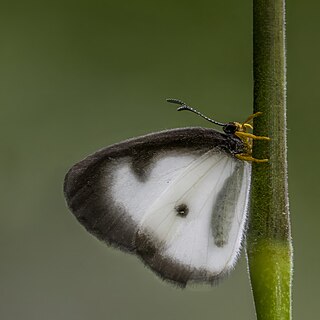
Lycaenidae is the second-largest family of butterflies, with over 6,000 species worldwide, whose members are also called gossamer-winged butterflies. They constitute about 30% of the known butterfly species.

Riodinidae is the family of metalmark butterflies. The common name "metalmarks" refers to the small, metallic-looking spots commonly found on their wings. The 1,532 species are placed in 146 genera. Although mostly Neotropical in distribution, the family is also represented both in the Nearctic, Palearctic, Australasian (Dicallaneura), Afrotropic, and Indomalayan realms.

Miletus is a genus of butterflies sometimes called brownies. Its species are found in the eastern Palearctic realm and the Indomalayan realm, and some stray east of the Wallace Line. The genus was erected by Jacob Hübner around 1819. Miletus is the type genus of the subfamily Miletinae.

Poritia is a genus of lycaenid butterflies. The species of this genus are found in the Indomalayan realm. Poritia was erected by Frederic Moore in 1887.

Aslauga is a genus of butterflies in the family Lycaenidae. They are associated with other insects and found only in the Afrotropical realm. They are small usually grey-blue or grey-purple butterflies with a distinctive, but widely varied wing shape, especially pronounced in A. pandora. They are forest butterflies of the Congolian forests and Lower Guinean forests.

Hypochlorosis is a genus of butterflies in the family Lycaenidae. The species of this genus are found on New Guinea and in the Moluccas in the Australasian realm.

Lachnocnema, commonly called woolly legs, is a genus of butterflies in the family Lycaenidae found mainly in Sub-Saharan Africa. Identification requires dissection to reveal subtle genital distinctions.

Ornipholidotos is a genus of butterflies, commonly called glasswings or white mimics, in the family Lycaenidae. The species of this genus are endemic to the Afrotropical realm.
Lachnocnema durbani, the D'Urban's woolly legs, is a butterfly of the family Lycaenidae. It is found from Cape Point and KwaZulu-Natal to Mozambique to Kenya, Malawi, Tanzania, and Uganda. The habitat consists of grassy areas in savanna.

Myrina sharpei, the Sharpe's fig tree blue, is a butterfly in the family Lycaenidae. It is found in the Republic of the Congo, the Democratic Republic of the Congo, Kenya, Uganda and Tanzania. The habitat consists of primary forest.

Pilodeudorix zela, the blue-edged playboy, is a butterfly in the family Lycaenidae. It is found in Senegal, Guinea-Bissau, Guinea, Sierra Leone, Liberia, Ivory Coast, Ghana, Nigeria, Cameroon, the Republic of the Congo, the Central African Republic, the Democratic Republic of the Congo, Uganda, north-western Tanzania and northern Zambia. The habitat consists of forests, including dry forests.

Pilodeudorix deritas, the small diopetes, is a butterfly in the family Lycaenidae. It is found in Ghana, Nigeria, Cameroon, the Republic of the Congo, Angola, the Central African Republic, the Democratic Republic of the Congo and Uganda. The habitat consists of forests.
Pseudonacaduba aethiops, the dark line blue or dark African line blue, is a butterfly in the family Lycaenidae. It is found in Africa from Nigeria to western Kenya and Zambia. The habitat consists of forests.
Oxylides albata, Aurivillius' common false head, is a butterfly in the family Lycaenidae. It is found in Nigeria, Cameroon, the Republic of the Congo, the Central African Republic, the Democratic Republic of the Congo, western Uganda and Rwanda.

Oxylides faunus, the common false head, is a butterfly in the family Lycaenidae. It is found in Guinea-Bissau, Guinea, Sierra Leone, Liberia, Ivory Coast, Ghana, Togo, Nigeria and Cameroon. The habitat consists of primary forests.

Hypolycaena lebona, the fairy hairstreak, is a butterfly in the family Lycaenidae. It is found in Sierra Leone, Liberia, Ivory Coast, Ghana, Togo, Nigeria, Cameroon, Gabon, the Republic of the Congo, the Central African Republic, the Democratic Republic of the Congo, Uganda and Tanzania. The habitat consists of forests.

Iolaus bellina, the white-spot sapphire, is a butterfly in the family Lycaenidae. It is found in Sierra Leone, Liberia, Ivory Coast, Ghana, Togo, Nigeria, Cameroon, São Tomé and Príncipe, Gabon, the Republic of the Congo, the Democratic Republic of the Congo, Uganda, Kenya and Tanzania. The habitat consists of forests.

Iolaus maesa, the chocolate-bordered sapphire, is a butterfly in the family Lycaenidae. It is found in northern Guinea, Sierra Leone, Ivory Coast, Ghana, Togo, Nigeria, Cameroon, the Republic of the Congo, the Democratic Republic of the Congo (Tshopo) and Uganda. The habitat consists of forests.

Lachnocnema luna, or Druce's large woolly legs, is a butterfly in the family Lycaenidae. The species was first described by Hamilton Herbert Druce in 1910. It is found in Ghana, eastern Nigeria, Cameroon, Gabon, the Republic of the Congo, the north-eastern part of the Democratic Republic of the Congo, Uganda and north-western Tanzania. The habitat consists of forests.

Lachnocnema reutlingeri, the Reutlinger's large woolly legs, is a butterfly in the family Lycaenidae. It is found in Ghana, Nigeria, Cameroon, Equatorial Guinea, Gabon, the Republic of the Congo, the Democratic Republic of the Congo, Sudan, and Uganda.
















